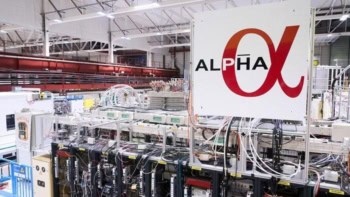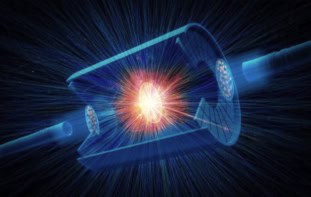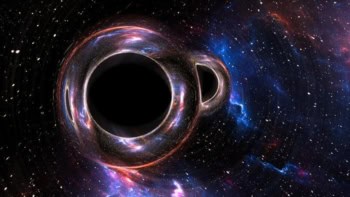With the Physics World 2019 Breakthrough of the Year due to be announced on 12 December, Physics World journalists look back at the past decade of winners and explore how research in that field has moved on. Here Hamish Johnston reflects on the 2012 award “to the ATLAS and CMS collaborations at CERN for their joint discovery of a Higgs-like particle at the Large Hadron Collider”

It was a long time coming. The existence of the Higgs boson was predicted in 1964, but the world had to wait until 2012 before it was discovered by physicists working on the ATLAS and CMS collaborations on the Large Hadron Collider at CERN.
So, what happened next?
The very next year, François Englert and Peter Higgs shared the Nobel Prize for Physics for their theoretical prediction of the Higgs boson in 1964. While it was pretty certain that the 2013 Nobel would be related to the Higgs discovery, there was much talk in the run-up to the announcement that the Nobel committee would break with tradition of a maximum of three winners and give at least a portion of the prize to the CERN collaborations.
Earlier this year I spoke to Lars Brink who was chair of the committee that awarded the 2013 prize. He explained that the three-person-maximum per prize rule is unlikely to ever be broken because the committee does not want to create thousands of laureates – which would have happened if ATLAS and CMS had won the Nobel.
More prizes
While I understand Brink’s sentiment, it is unfortunate that ATLAS and CMS missed out on a Nobel – although I suppose it is possible that three leading physicists from the collaborations could bag a future Nobel prize.

There are other physics prizes and in December 2012, a special prize from Yuri Milner’s Fundamental Physics Prize Foundation was shared by seven physicists who headed CERN’s Large Hadron Collider (LHC), ATLAS and CMS. This included a massive $3m in prize money that was split amongst the winners.
Meanwhile at CERN, work on the Higgs has progressed by leaps and bounds since 2012. Indeed, you may recall that the original discovery was described as a “Higgs-like boson” – but I think it’s now pretty certain that it is the particle that was predicted 55 years ago.
This week I had a chat with particle physicist Uta Klein at the University of Liverpool, who works on the ATLAS experiment and is also involved in planning for the next generation of colliders after the LHC.
Deeper understanding
She told me that since 2012, physicists have gained a much deeper understanding of the mechanisms that lead to the production of the Higgs boson when protons are smashed together at the LHC. They also have a much better understanding of how the Higgs quickly decays to other particles, which are then detected by the huge experiments along the collider.
Klein points out that an important milestone came just last year, when ATLAS confirmed that the Higgs decays to a to a bottom quark/antiquark pair. This is the most common decay channel for the Higgs at the LHC and should account for nearly 60% of all decays – but had proven extremely difficult to spot it amongst the vast number of particles that are produced by proton-proton collisions at the collider.
Also last year, physicists working on both ATLAS and CMS made discovery level measurements of a relatively rare process whereby the Higgs is produced in conjunction with a top quark/antiquark pair.
Studying how the Higgs couples to quarks provides important insights into how quarks acquire their masses. This, in turn could provide clues about the microscopic mechanism that caused the Higgs field to emerge and fill space and time, which is poorly understood. The strong nature of the Higgs-top quark coupling also means it should be relatively straightforward to detect any possible deviations from the Standard Model, which could point to new physics.
Rarer decay channels
Physicists have also been sifting through the vast amounts of data from the LHC to get a better understanding of some of the rarer decay channels taken by the Higgs. These include how the Higgs decays to a muon/antimuon pair, which has not yet been measured at discovery level. This would provide important insights into how the Higgs interacts with leptons and shed light on how these second-generation leptons acquire mass.
The holy grail of Higgs physics is a determination of whether the Higgs boson couples to itself. This coupling was predicted many years ago by Higgs, Englert and Robert Brout (who died in 2011, so missed out on the Nobel) and is at the core of the Standard Model. Self-coupling could be seen at the LHC in the form of pairs of Higgs bosons, but these are rarely produced in the proton-proton collisions.
In 2026 the LHC is | switch on after undergoing a high-luminosity upgrade, which will increase the proton-proton collision rate by a factor of 10. That means a lot more Higgs bosons to study, so hopefully physicists will get a better handle on those rare processes including double Higgs production.
Next-generation colliders
Looking further into the future, there are several types of next-generation collider that would cast more light on the Higgs. One proposal is the 100 km circumference Future Circular Collider (FCC), which is a larger version of the LHC that would collide protons at collision energies of about 100 TeV – compared to 13 TeV at the LHC. This would produce vast numbers of Higgs particles that could be studied.
An important challenge would be to isolate Higgs-related signals from the vast numbers of unrelated particles that would also be produced. That’s where an electron-positron collider such as the proposed International Linear Collider or Compact Linear Collider come in. Although such a facilities would operate at much lower collision energies (about 1 TeV), they would be “clean” sources of Higgs particles with a much lower background of other particles getting in the way.
A third option is a hybrid of the two approaches, smashing protons into electrons. This is the aim of the Large Hadron Electron Collider, which would involve building an electron accelerator at CERN and smashing the electrons into protons from the LHC.
Klein believes that building all three types of collider would be the best way forward. Whatever happens, physicists are bound to learn much more about the Higgs – and with a little luck, intense study of the Higgs could reveal new physics beyond the Standard Model



